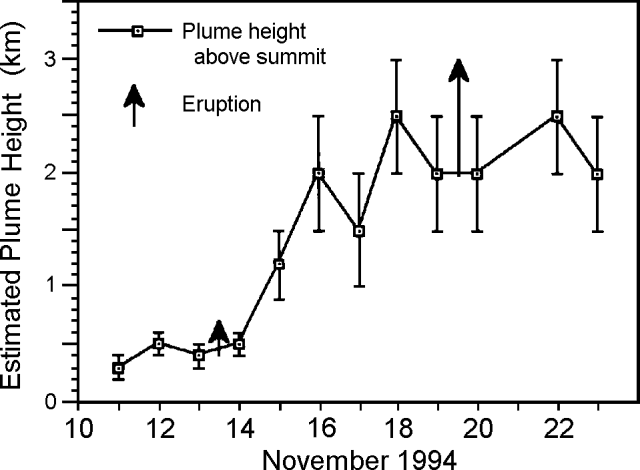Report on Lascar (Chile) — November 1994
Bulletin of the Global Volcanism Network, vol. 19, no. 11 (November 1994)
Managing Editor: Richard Wunderman.
Lascar (Chile) Small phreatic eruptions
Please cite this report as:
Global Volcanism Program, 1994. Report on Lascar (Chile) (Wunderman, R., ed.). Bulletin of the Global Volcanism Network, 19:11. Smithsonian Institution. https://doi.org/10.5479/si.GVP.BGVN199411-355100
Lascar
Chile
23.37°S, 67.73°W; summit elev. 5592 m
All times are local (unless otherwise noted)
Observations during 11-23 November revealed a plume of variable strength, indicating continuing instability, and the volcano was not climbed. The fumarole on the N rim was visible and appeared to be stronger than in February. A small phreatic eruption at 1720 on 13 November ejected a brownish column ~700 m above the crater which was then blown SE. This event was preceded by a weak, diffuse vapor plume which reached 300-500 m above the crater. Following the eruption, the plume gradually strengthened, reaching altitudes of 2-2.5 km above the summit . . . by 16 November (figure 23). The plume became more dense, yellowish to brownish in color, and pulsed, ejecting "ashy slugs" every 5-15 minutes. A second phreatic eruption observed at 1720 on 19 November emitted a dense white plume to 3 km above the crater. Although sheared by wind to the SE, it retained its form for ~20 minutes.
 |
Figure 23. Plume altitudes and phreatic eruptions at Lascar, 11-23 November 1994. Courtesy of S. Matthews. |
Similar activity was observed by Matthews in February, and was related to continuing collapse of the crater floor. In this interpretation, blockage of the degassing system leads to a weak plume and buildup of pressure beneath the crater floor. Periodic phreatic eruptions clear the conduit and allow the gas to vent freely, causing the plume to strengthen; the reason for the strong pulsing is not clear.
Geological Summary. Láscar is the most active volcano of the northern Chilean Andes. The andesitic-to-dacitic stratovolcano contains six overlapping summit craters. Prominent lava flows descend its NW flanks. An older, higher stratovolcano 5 km E, Volcán Aguas Calientes, displays a well-developed summit crater and a probable Holocene lava flow near its summit (de Silva and Francis, 1991). Láscar consists of two major edifices; activity began at the eastern volcano and then shifted to the western cone. The largest eruption took place about 26,500 years ago, and following the eruption of the Tumbres scoria flow about 9000 years ago, activity shifted back to the eastern edifice, where three overlapping craters were formed. Frequent small-to-moderate explosive eruptions have been recorded since the mid-19th century, along with periodic larger eruptions that produced ashfall hundreds of kilometers away. The largest historical eruption took place in 1993, producing pyroclastic flows to 8.5 km NW of the summit and ashfall in Buenos Aires.
Information Contacts: S. Matthews, Univ of Bristol.

